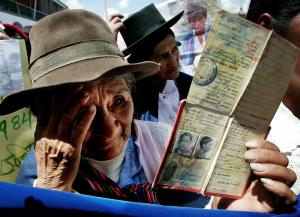Issue Date: September 19, 2003
By BARBARA J. FRASER Calling Peru’s decade-plus of political violence and military repression “a national shame” and “a mark of horror and dishonor for the state and Peruvian society,” the country’s Truth and Reconciliation Commission on Aug. 28 presented a nine-volume report to President Alejandro Toledo. Weeks before the report, a compendium of two years of work, was released, critics -- including politicians, retired military officers and Cardinal Juan Luis Cipriani -- were making headlines, criticizing everything from the commission’s makeup to the use of the word “reconciliation.” The commission’s conclusions were both more and less damning than its detractors may have feared. The panel blamed the Maoist Shining Path, not the military, for launching the violence that wracked the country beginning in 1980 and for half the killings. It added, however, that government forces had committed systematic human rights violations. And while it blamed the three democratic governments of those years for leaving anti-subversive policy in the hands of the military, it did not hold the former presidents individually responsible for specific cases. While praising the work of Catholic and evangelical church workers in defending human rights, the commission criticized Cipriani, who was bishop of Ayacucho, the highland region that was home to most of the victims, for his failure to take a stand against military repression there. But the most shocking conclusion was that about 70,000 people -- more than twice the generally cited estimate -- were killed or disappeared during the past two decades. About 79 percent of the victims were from rural areas and 75 percent spoke Quechua or another indigenous tongue as their first language. More than half were peasant farmers. “What does this say about our political community, now that we know that we lost 35,000 more brothers and sisters without anyone realizing it?” asked Salomón Lerner, rector of the Pontifical Catholic University of Peru and head of the commission, when he presented the report. The commission based its estimate on information gathered from more than 16,000 witnesses over the past two years. “In 1980, when the war started, there were 2 million Peruvians who weren’t even registered as citizens,” said Francisco Soberón, executive secretary of the National Coordination Network of Human Rights. “This reflects the deep gap that exists in Peruvian society.” That gap -- which divides wealthy, white or mixed-race Peruvians in Lima from the poor, indigenous population of the Andean highlands and Amazon rain forest -- was described as underlying cause of the violence that erupted in May 1980, when Sendero Luminoso or Shining Path, militants burned ballot boxes in a remote village in the highland department of Ayacucho. That day marked the country’s return to democracy after more than a decade of dictatorship. It also launched an escalating spiral of confrontations between Shining Path and security forces. The Truth and Reconciliation Commission’s report contradicts earlier studies that attributed about 80 percent of deaths during those years to the military, blaming Shining Path and Peru’s other main subversive group, the Tupac Amaru Revolutionary Movement, for only 20 percent. Abimael Guzmán, the professor-turned-messianic-leader of the Shining Path, met with commission members several times, but refused to videotape a statement when he found out how harsh the panel’s conclusions would be. The picture that emerges from the report is of a country deeply divided along racial lines, in which discrimination and government neglect created a breeding ground for radical politics that first flourished at San Cristóbal University in Ayacucho, where Guzmán taught. Peasant communities were caught in the crossfire between Shining Path and the military. At times, “it wasn’t a matter of battles between Shining Path columns and military forces, but the mobilization of peasants against peasants by both contingents,” said sociologist Nelson Manrique, who researched military strategy for the commission. “It is important that this report not just stay on the shelf accumulating dust,” Lerner said several months before it was released. But less than a week after the commission was officially dissolved Aug. 30, the issue was already fading from the headlines. “If the Peruvian judicial system does not respond to people’s demands for justice, the so-called reconciliation process will not be possible,” Soberón said. “Many of the people who have testified before the commission have said they want justice even more than reparations.” The commission submitted several dozen cases of human rights violations by military officers to the Public Ministry to begin legal proceedings. Commission members said the information they gathered can also be used by human rights organizations, victims and relatives in other cases. Soberón called for special prosecutors to be named in the seven departments where the greatest number of deaths and disappearances were recorded. These include the upper Huallaga River valley, the coca-growing area where subversive activity, military repression and drug trafficking converged in the 1980s. One investigator who worked with the commission called the Huallaga River “the country’s largest mass grave.” In all, the commission recorded 4,644 clandestine graves. Preliminary investigations were done at 2,200 graves and forensic teams excavated three. The panel’s conclusions call for completing that work, as well as reparations for victims of human rights violations committed by both government forces and the subversive groups. The government has paid indemnities to families of victims in two high-profile cases involving death squads linked to the government, but Soberón said the reparations “must be for all the victims, not just those of government forces but also the victims of Shining Path.” The commission also called for a series of government reforms. These included assigning government officials to rural areas where there are no government offices; creating a government agency on indigenous and ethnic affairs; ensuring civilian control of security forces and military intelligence; and establishing an independent, efficient judicial system. Barbara Fraser is a freelance writer in Lima, Peru. National Catholic Reporter, September 19, 2003 |
